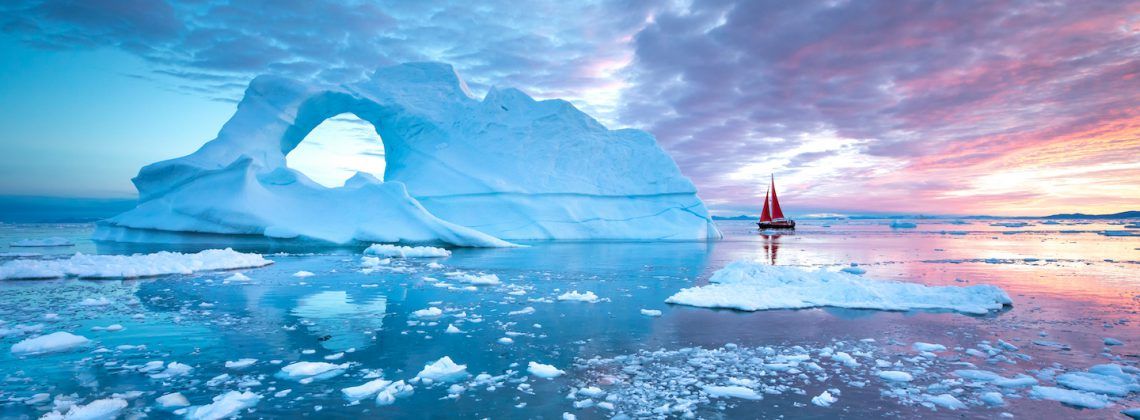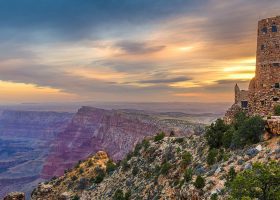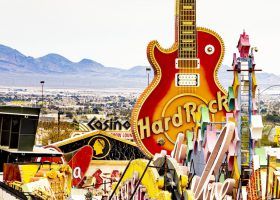Do you like the Vikings? You should because they were awesome! But maybe you don’t know exactly how much the Vikings influenced Europe or where they left traces of their civilization. I’m a Viking historian, so I know the truth about Vikings and what you should know. Here’s the top places you should visit to understand Vikings.
Places in Europe Where Vikings Made Their Mark
The Vikings are one of the most romanticized and misunderstood civilizations in Europe. People often think of them as big burly guys with horned helmets setting villages on fire and drinking beer. However, they were definitely not like that – except the setting places on fire part.
The Vikings were innovative and revolutionized warfare in the Middle Ages. Moreover, they were amazing traders and traders, and their women had allegedly better rights than many of their contemporaries in Europe!
So if you want to find out more about these fascinating people, their way of life, and what they meant for the continent, read on!
Viking Ships in Oslo
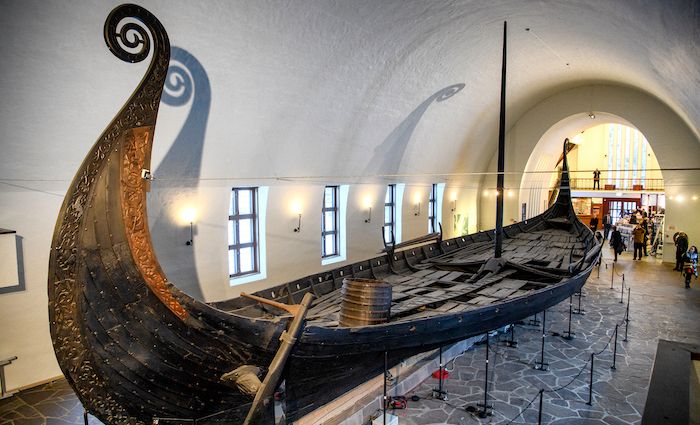
Epic Ships | Viking Burials | Kings & Queens
The Vikings are best known for their ships. And to see the best Viking ships in the world, you need to go to Oslo. The Viking Ship Museum houses some of the best-preserved Viking ships: the Oseberg and Gokstad ships. Both date from the 9th century. The Oseberg ship is a burial vessel containing the remains of 2 women. The oldest one would have been 80 years old at the time of death, the other one being a much younger woman, perhaps a servant or handmaid.
According to Jesch, the woman was either a priestess or Queen Åsa, the grandmother of Harald Fairhair, the unifier of Norway. This speaks volumes about the importance and power women held in Viking Age society.
On the other hand, the Gokstad ship was one of the famous warships of the Vikings. The ship was built during King Harald Fairhair’s reign when Viking raids from Norway were assailing England and Ireland. The ship could carry a crew of about 30 men across the Northern Sea and the Atlantic.
These were the ships that terrorized Europe for hundreds of years. Moreover, they would take explorers all the way to the American continent. Viking ship technology, according to Gareth Williams, revolutionized the medieval world and set foundations for the future development of navigation tools and methods.
Viking Temple in Sweden
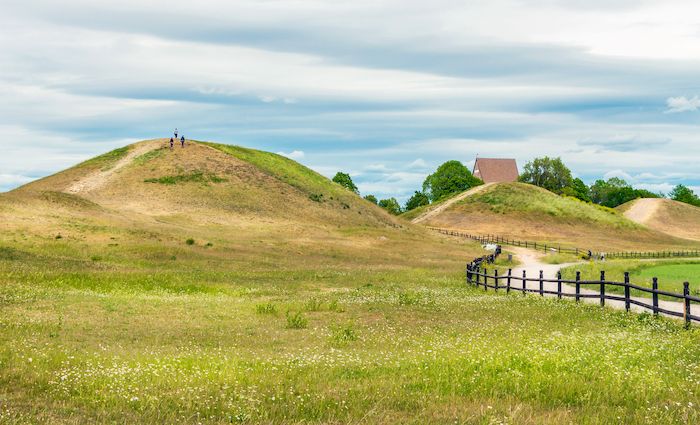
Temple | Sacrifices | Burial Mounds
Gamla Uppsala was one of the few documented temple sites of the Norse religion. The cult of the Norse pantheon has roots in the Bronze Age and parallels Greek and Hindu mythology. According to Parker Pearson, this is because all of these beliefs came from the same tribes that then moved across Europe, spread it, and adapted it to their new homes and ways of life.
Here at Uppsala, the chronicle of Adam of Bremen says the Norse worshipped Odin, Thor, and Freyr. Odin, also called the Allfather or Wise-One, was the leader of the Norse gods. Many kings of the Vikings claimed to descend from his line. Thor, the god of thunder, has become popular thanks to its appropriation and reinvention in the Marvel comics.
Thor is the son of Odin, killer of giants, and protector of mankind in that respect. On the other, Freyr is a god of fertility. In addition, Gamla Uppsala would have been a site for the ritual of blót: a blood sacrifice. According to Dougherty, the Norse celebrated 2 different festivities including sacrifices and blood rituals. These corresponded with the winter and summer solstices.
Finally, in Uppsala, we also have some famous burial mounds. Originally known as the Royal Mounds, these were supposed to be the resting places of the gods. Later on, the name changed because it was believed to be the burial site for members of the semi-legendary Yngling kings of Sweden from the 5th and 6th centuries. Excavations revealed the burial of some royal members and potentially other people, perhaps victims of the sacrifices.
Viking Fortress in Denmark
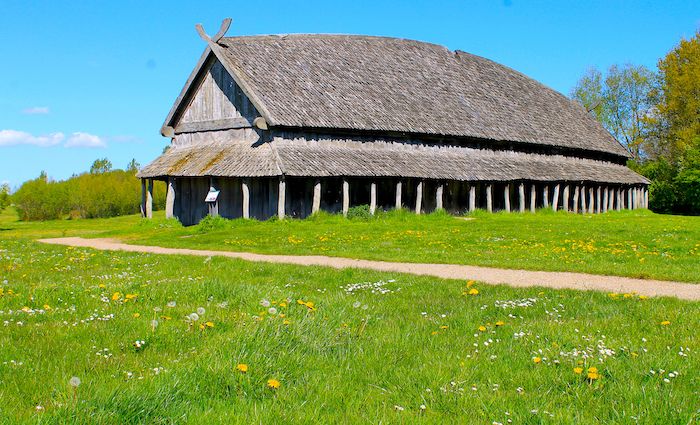
Fortress | Open Air Museum | Immersive Experience
Trelleborg is the best-preserved ring fortress from the Viking Age dated from the 10th century. We believe King Harald Bluetooth commissioned it. The importance of Trelleborg lies in a few aspects. Firstly, this inland location suggests turmoil in the reign. After all, the Vikings were not a unified people, and rebellion and contenders were always on the horizon.
Moreover, you can see what ordinary life would have been for the Northmen. You can visit a blacksmith workshop and weavers practicing their tablet weaving to embellish their gowns. You can even go inside the longhouse! This is a recreation of a traditional Viking hall: a domestic building where to sleep, eat and cook.
When I was there, I had the privilege to eat a traditional Norse meal: porridge. This porridge wasn’t like the nice creamy one you’d make at home, but it was similar enough. It showed that the Vikings were people just like us. And this is one of the great things Trelleborg does.
Moreover, Trelleborg was a town with people doing ordinary things. There is evidence for merchants and craftsmen. For all the terror and bad press their contemporaries wrote about them, the Vikings were not bloodier or more violent than their contemporaries. But they were not Christian, and their tactics were rather surprising.
They were the perfect scapegoats for all the struggling Christian kingdoms in Europe. However, the people we often see depicted in the books were just small raiding parties. The majority of Norse society would have been at home caring for their cattle and making porridge, going about their day just like anyone else here on Trelleborg.
The First Parliament in Europe was Viking!
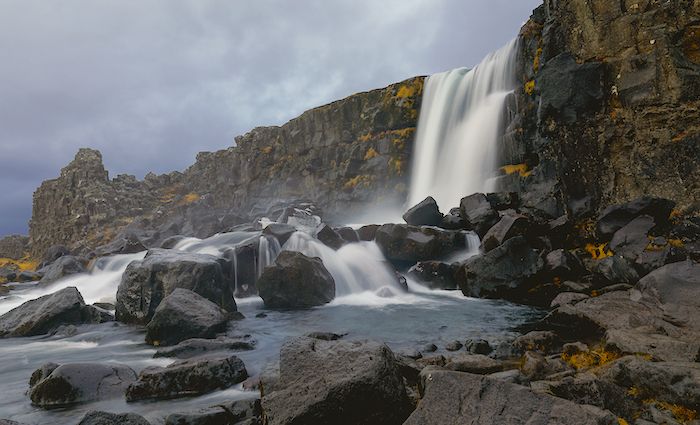
First Parliament | National Park | Epic Views
Did you know the Vikings were the first to create a Parliament and advocate for our modern sense of democracy through this representation system? Well, we have evidence across Scandinavia for reunion places for this kind of representation called assemblies.
But Thingvellir in Iceland was the first official site to hold a proper parliament. This is because Iceland had no king or ruler. Instead, each community regulated itself with the help of chieftains, whose role was mostly ceremonial.
According to Byock, many of the settlers of Iceland fled Norway to escape the rule of King Harald Fairhair because of political issues or to avoid conversion. Harald tried to unify the people of Norway through military prowess and Christianity. However, according to William R Short, life in Iceland was hard, and the settlements did rely upon each other to some extent for survival, whether this was for the continuation of families, trade of goods and information, etc.
Eventually, in 930, the Althing (the great assembly) moved to Thingvellir. This location provided an accessible area and good common ground for everyone in Iceland. Moreover, they chose a natural formation known as the Law Rock, where the law speaker, the person in charge of remembering the laws of Iceland to impart justice, would give their speeches.
The Vikings in England
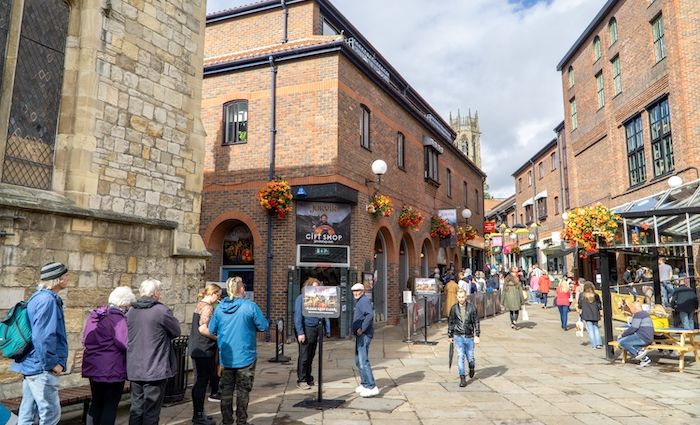
York | Traditing Network | Sons of Ragnar Lothbrok
The Jorvik Centre is an experience unlike many others in Europe. This museum holds a collection of artifacts from Viking Age York. It also has recreation with animatronics of what Jorvik would have looked, sounded, and smelled like in the Middle Ages!
It is like a train ride where you learn the history of York: the most important Viking settlement in England. York was a prolific trading town and port. Archaeological evidence from York shows that the Viking trading network went all the way to the other side of the known world, including cowrie beads from the Persian Gulf and the Red Sea.
A big portion of England became Viking territory known as the Danelaw. Part of the reason why the Viking Age began was that Scandinavia was a hard place to live in. Farmlands were often not as fertile as in other parts of Europe. Besides, they did not have many resources. Therefore, the second, third, and later sons of many families had to find their fortune somewhere else.
That was one of the precursors for raiding parties that paved the way for the Great Heathen Army (865 AD). This was a huge military force that raided and conquered England. The Anglo Saxon Chronicle recorded the names of its leaders: the famous Halfdan Ragnarsson or Ivar the Boneless, both sons of the legendary Ragnar Lothbrok.
Normandy
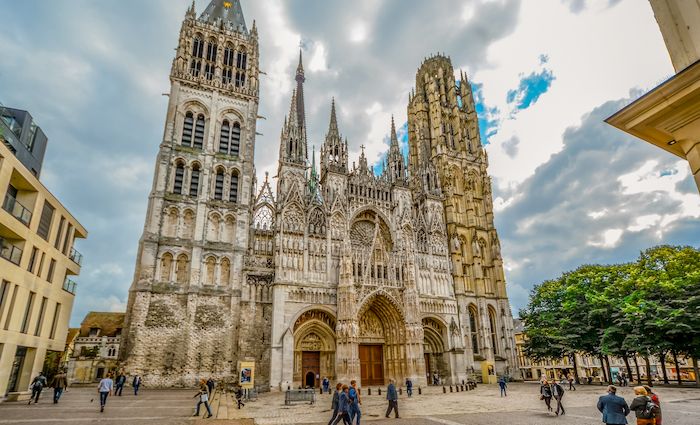
Rouen | Famous Viking | Duchy of Normandy
Rouen Cathedral is the burial site of one of the most famous Vikings: Rollo. You may know him from the tv series Vikings. He became the first duke of Normandy and established the lineage of the normans who would then come to reign a great part of France, England, Ireland, and Sicily.
In fact, even the name Norman indicates their Viking lineage. It comes from the Latin Normanni, which means Northmen. According to Hagger, France was a common raiding ground and the north was particularly profitable for the Northmen because there was a lot of infighting, which meant less resistance.
Unable to get rid of these feisty Northmen, the king of Francia saw an opportunity to keep order up north. Therefore, King Charles III paid Rollo to stay around Rouen in exchange for him to keep other Vikings away. Dudo of St Quentin recorded these events. In addition, Rollo had to convert to Christianity as a gesture of good faith that he was now a subject of France and not a heathen. This is how the Duchy of Normandy started in 911 with its capital in Rouen.
The Vikings in Ireland
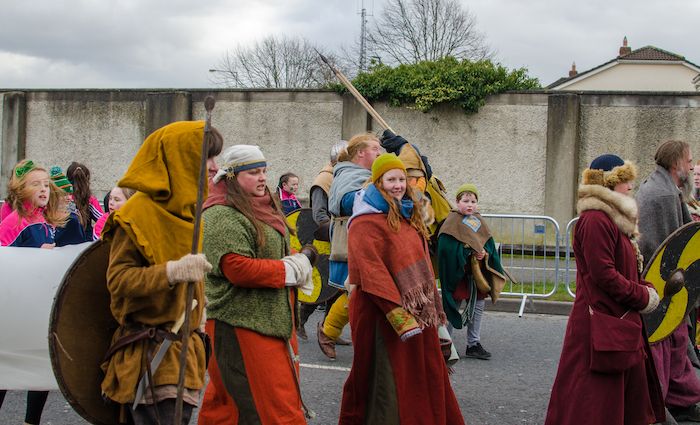
Dublin | Trading Goods | Medieval Battles
Dublinia is a reenactment centre where you experience the life of Viking Age and Medieval Dublin. From the Hiberno-Norse colony of Ireland, we have some of the most beautiful pieces of jewellery of this period. Ireland produced great metalworks and art at the time, so the Norse influence allowed these traditions to blossom even further.
Moreover, Dublin was one of the most important settlements of the Viking world. The relationship between the Norse and the Irish was a bloody one. According to Walsh, the Vikings had been raiding the coast of Ireland since 795. The incursions started getting bigger and better organized and eventually, most of Ireland was under Viking control, with Dublin becoming the main center of activity.
However, even after the Vikings subdued and mixed with the Irish, more Vikings kept coming and fighting with the previous Vikings. So Ireland saw blood running for centuries on.
However, according to Purcell and Sheehan, Dublin was an important resource for the Vikings as a trading port and provider of a great commodity in the world: slaves. Slaves were property in Norse society just like in Roman times. In addition, with the Viking trade routes going as far as Asia, the slave trade was incredibly profitable.
Epic Viking Warriors in Istanbul
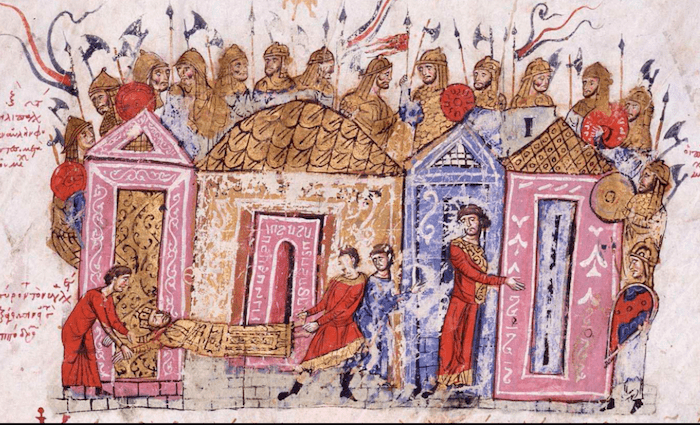
Varangian Guard | Elite Soldiers | King Harald Hardrada
We know the Byzantine emperor kept an elite group of warriors called the Varangian guard. According to Sigfus Blondal, these recruits first came to Constantinople from the Rus in the 9th century. in fact, Viking inscriptions have been found at the Hagia Sofia!
It is likely they were mercenaries or levies that the Rus sent to the emperor to keep the peace after many years of conflict. Their prowess and fierceness set them apart from other regiments, and they carved themselves this elite unite that became the personal guard for the emperor.
According to Bob Priestly, this was a way for many men to earn a living and improve their skills in battle, as well as increase their renown which would serve them greatly in their return to Scandinavia. King Harald Hardrada was one of the most famous Varangian guards. He served there during his exile before returning to Norway to become king in 1045. Barely decades later he’d be taking to the seas to claim the throne of England in 1066, where he’d met his death at the battle of Stamford Bridge.
Viking Reenactment in Poland
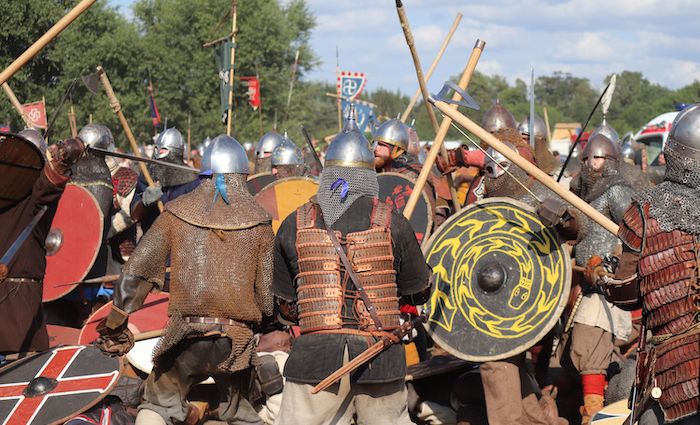
Wolin | Reenactment Festival | Jomsvikings
Wolin holds the Festival of the Slavs and the Vikings, which is one of the most impressive medieval re-enactment festivals in Europe. It includes the re-enactment of battles, daily activities, ceremonies, as well as talks on different aspects of the early people of the Baltic.
According to the sagas, and particularly Jomsvikinga Saga, the Jomsvikings were the most exclusive mercenary warband in the Viking world. Being a Jomsviking was almost as good as being a Varangian guard. Jomsvikings acted as mercenaries for anyone who could afford their services, Norse, Christians, and beyond.
Their legendary stronghold, (still much debated amongst historians) seems to have been located in Wolin, an island on the Baltic off the coast of Poland. Moreover, recent archaeological and historical discoveries suggest a connection between king Harald Bluetooth and Jomsborg in Wolin. These reinforce that Wolin was indeed the location for Jomsborg. Moreover, Harald may have even commissioned the stronghold and died there.
The Vikings in Russia
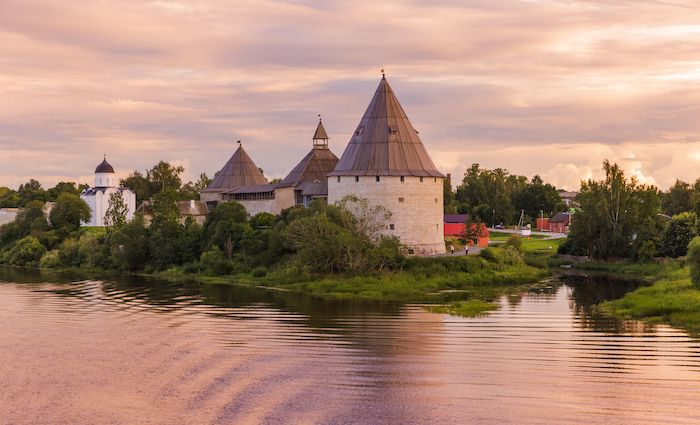
Staraya Ladoga | The Viking Rus | Tomb of King Oleg
Staraya Ladoga was one of the most important Viking settlements in the east. King Rurik founded this riverside fortress. From Ladoga he expanded his power until he ruled half of eastern Europe including Novgorod and Kyiv.
Its importance as a trading port lay in the transit of goods from the Baltic to Constantinople and the Caspian Sea. In addition, it also connected with all the trade routes that travelled through the Volga. Most goods from the middle east came into Europe through Ladoga.
Furthermore, there are some important burial mounds in Ladoga. A popular legend says that one of these burial mounds contains the remains of Oleg of Novgorod, the successor of King Rurik. Oleg is a crucial figure for the Vikings and eastern Europe as he was the one to seize power in Kyiv and formed the Kievan Rus state. However, the Russian primary chronicle and the Kievan chronicle suggest Oleg’s burial is in Kyiv.
Viking Saints in Ukraine
St. Olga | Viking Women | Christianity
Olga of Kiev is one of the most amazing Viking women in history. The Drevlians killed Igor: Olga’s husband and ruler of Kiev. Her son Sviatoslav was a minor, so she became queen. And then she crushed her enemies and avenged her husband. Olga became a great politician. According to the Russian Primary Chronicle, she strengthened relationships with neighboring countries, including a most intriguing relationship with the Byzantine emperor.
According to Judith Jesch, the emperor Constantine was apparently fascinated by this woman – though admittedly he was more interested in acquiring and subjugating for once for all Kievan Rus. In any case, Olga denied all his advances but one: she went to Constantinople and converted to Christianity, taking the name Helena. Olga knew Christianity was on the rise and the way for her people to survive was through conversion. So she took the first step.
It would be her grandson Vladimir I who would manage the conversion of the Rus that allowed further development for the land. However, none of this would have been possible without his grandmother. Since then, St Olga became a saint in the Eastern Orthodox church. There are now countless churches dedicated to her and her grandson in Ukraine and Eastern Europe.
The Vikings in Greenland
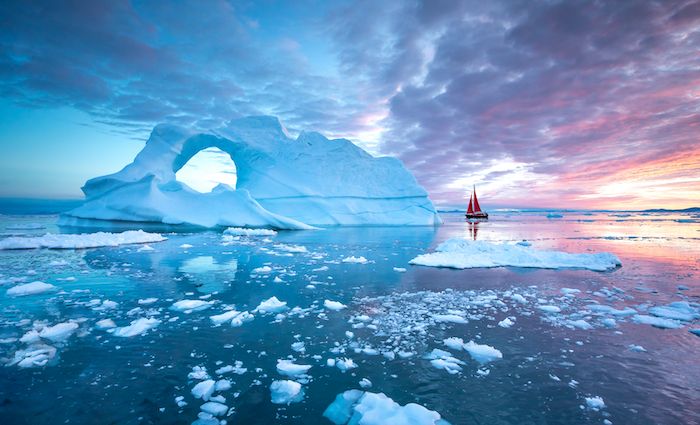
Kujataa | Subarctic Destinations | UNESCO Heritage
You probably wouldn’t think about going to Greenland to see Unesco heritage. Yet, the site at Kujataa is a subarctic farming landscape from the Norse and the Inuit people of Greenland. Erik the Red, started the Norse settlement of Greenland. He was exiled from Iceland for killing another man.
Therefore, he went to Greenland, and others followed shortly afterward. Here you can see archeological patrimony unlikely to be found in this landscape: agricultural remains of the settlements they made. Moreover, The Saga of the Greenlanders and the Saga of Erik the Red tell us how from this settlement Leif Erikson departed in search of Vinland. Without the Viking colonies in Greenland, we would have never had the Viking settlement in L’Anse aux Meadows (Canada).
The Viking Raided Seville!
Seville | Bjorn Ironside | Walled Medieval Town
The story of the walls you see today in Seville started in 844. The Vikings, led by the legendary Bjorn Ironside (also a son of Ragnar), set camp in Isla Menor. This is an island in the Guadalquivir river that allowed them to deploy guerrilla tactics. Muslim forces tried to defeat them but failed.
With most of their military forces incapacitated, Seville was left defenseless, and the Vikings took it by force and fire. Ibn Idhari and al-Nuwayri record the events in detail. Most of the walls and defenses of the city were burned in that attack, so after the Vikings were expelled by Abd ar-Rahman II, he invested greatly in improving the defenses of the city.
The Vikings in Germany
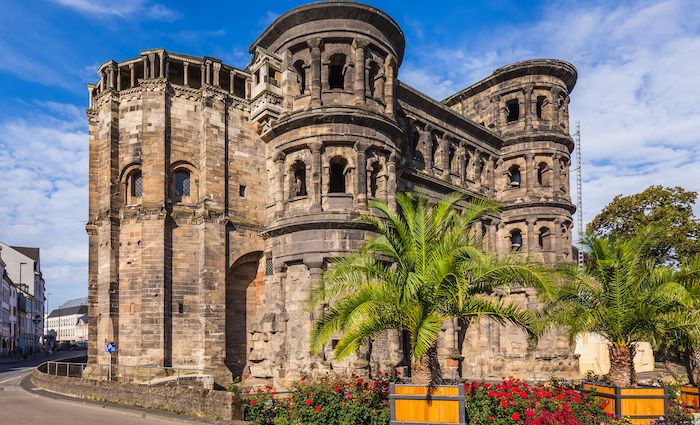
Trier | Porta Nigra | Roman Fortress
People often forget that the Vikings went everywhere they could, particularly if there was a river they could navigate. And the Rhine provided them with an exceptional gateway into central Europe. They conducted several raids during the mid 9th century across this area.
One of the most renowned ones was the Moselle raid of 882. King Louis III of Francia died as he was fighting off the Northmen in the Rhineland. So, the Vikings gained a free pass into modern-day Germany. This raid took place during Easter. Trier was a juicy target because of its cathedral and monasteries.
Despite the remains of their Roman fortress, which you can still see at Porta Nigra, this was not enough to stop the Viking raiders. According to Regino of Prum, the Vikings plundered the city and many inhabitants fled to Metz.
Now that you have read this, I think you are ready to grab your sword and shield and join our warband in one of these fantastic destinations in Europe. Just remember, no horned helmets!
